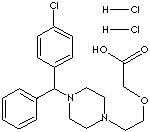
Cetirizine dihydrochloride
CAS
NO. 83881-51-1
Chemical Formulas

CAS NO.
83881-51-1 (Base)
FORMULA
C21H23ClN2O3·2HCl
MOL WT. 461.82
SYNONYMS
(1S.2S)-2-Methylamino-1-phenyl-1-propanol dichloride;
PHYSICAL AND CHEMICAL PROPERTIES
PHYSICAL STATE white to off-white crystalline powder
MELTING POINT
BOILING POINT
SPECIFIC GRAVITY
SOLUBILITY IN WATER Soluble (Insoluble in acetone )
Cetirizine dihydrochloride is an antihistamine widely used in the relief
of hayfever and other allergies, the usual dosage is a single tablet
containing 10 mg taken once a day by persons over the age of twelve -
some sources advise cetirizine dihydrochloride is safe for children over
the age of six. Cetirizine dihydrochloride should not be taken by
pregnant or breast-feeding women, and can cause drowsiness, dizziness,
agitation, stomach upset and intestinal pain
Effects of cetirizine dihydrochloride on
human lymphocytes in vitro: micronucleus induction. Evaluation of
clastogenic and aneugenic potential using CREST and FISH assays.
This
medicine contains the active ingredient cetirizine, which is a type of
medicine called a non-sedating antihistamine. It works by preventing the
actions of histamine.
All this results in the symptoms of an allergic reaction. In hayfever,
histamine causes inflammation of the nose, eyes, skin or airways and
results in itchy watery eyes, a runny nose, sneezing and nasal
congestion.
The released histamine then binds to its receptors (H1 receptors),
causing a chain reaction that results in allergic symptoms. It causes an
increase in blood flow to the area of the allergy, and the release of
other chemicals that add to the allergic response.
Information
Associated with Product :
Dosage
Uses
Side Effects
Pharmacology


PDF DOWNLOAD
WORD DOCUMENT
|









